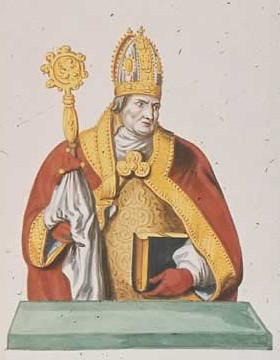St. Willehad

In this mural painting in the city hall of Bremen, Charlemagne and St. Willehad flank the Cathedral of Bremen as it appeared c1532
Bishop at Bremen, born in Northumberland before 745; died at Blecazze (Blexen) on the Weser, 8 Nov., 789. He was a friend of Alcuin, and probably received his education at York under St. Egbert. After his ordination, with the permission of King Alchred he was sent to Frisia between 765 and 774. He cannot, therefore, have been a disciple of St. Boniface, as Baronius states in the Roman Martyrology, for St. Boniface had left England in 718 and had died in 754 (755). Willehad came to Dockum, where St. Boniface had received the crown of martyrdom, and made many conversions. He crossed the Lauwers, but met with little success at Hugmarke (now Humsterland in the Diocese of Münster). He was obliged to leave and went to Trianthe (Drenthe in the Diocese of Utrecht). At first all seemed favourable, but later he made little progress. In 780 he was sent by Charlemagne to Wigmodia near the North Sea, between the Weser and the Elbe. There God’s blessing accompanied his labours, and he built many churches. The insurrection of the Saxons under Widukind in 782 put an end to his work, many of his companions were killed and his churches destroyed.
 Willehad escaped and went to Rome, where he was received by Adrian I. He then retired to the Abbey of Echternach, and applied himself to the task of copying books, among others he transcribed the Epistles of St. Paul. When the insurrection had been suppressed by Charlemagne Willehad returned to Wigmodia and continued his labours. He was consecrated bishop at Worms on 13 July, 787, and fixed his residence at Bremen, where he built a cathedral, dedicated on Sunday 1 Nov., 789, in honour of St. Peter. A few days later, while on a missionary tour, he was attacked with a fever and died. His body, buried at the place of his death, was transferred by his successor St. Willericus to the stone church built by him and placed in a chapel. A feast on 13 July commemorates the date of his consecration. During the Reformation his relics were lost. His feast was neglected and then forgotten; by permission, however, of the Sacred Congregation of Rites it was reintroduced in 1901 in the Dioceses of Munser, Osnabruck, and Paderborn to be observed on a vacant day after 8 November. His life was written by a cleric of Bremen after 838, but perhaps before 860. The account of his miracles was written by St. Ansgar.
Willehad escaped and went to Rome, where he was received by Adrian I. He then retired to the Abbey of Echternach, and applied himself to the task of copying books, among others he transcribed the Epistles of St. Paul. When the insurrection had been suppressed by Charlemagne Willehad returned to Wigmodia and continued his labours. He was consecrated bishop at Worms on 13 July, 787, and fixed his residence at Bremen, where he built a cathedral, dedicated on Sunday 1 Nov., 789, in honour of St. Peter. A few days later, while on a missionary tour, he was attacked with a fever and died. His body, buried at the place of his death, was transferred by his successor St. Willericus to the stone church built by him and placed in a chapel. A feast on 13 July commemorates the date of his consecration. During the Reformation his relics were lost. His feast was neglected and then forgotten; by permission, however, of the Sacred Congregation of Rites it was reintroduced in 1901 in the Dioceses of Munser, Osnabruck, and Paderborn to be observed on a vacant day after 8 November. His life was written by a cleric of Bremen after 838, but perhaps before 860. The account of his miracles was written by St. Ansgar.
BUTLER, Lives of the Saints; Staunton, A Menology of England; HAUCK, Kirchengesch. Deutschl., II (Leipzig, 1904), 350, etc.; WATTENBACH, Deutsch. Geschichtsqu., I (Berlin, 1904), 296.
FRANCIS MERSHMAN (Catholic Encyclopedia)









